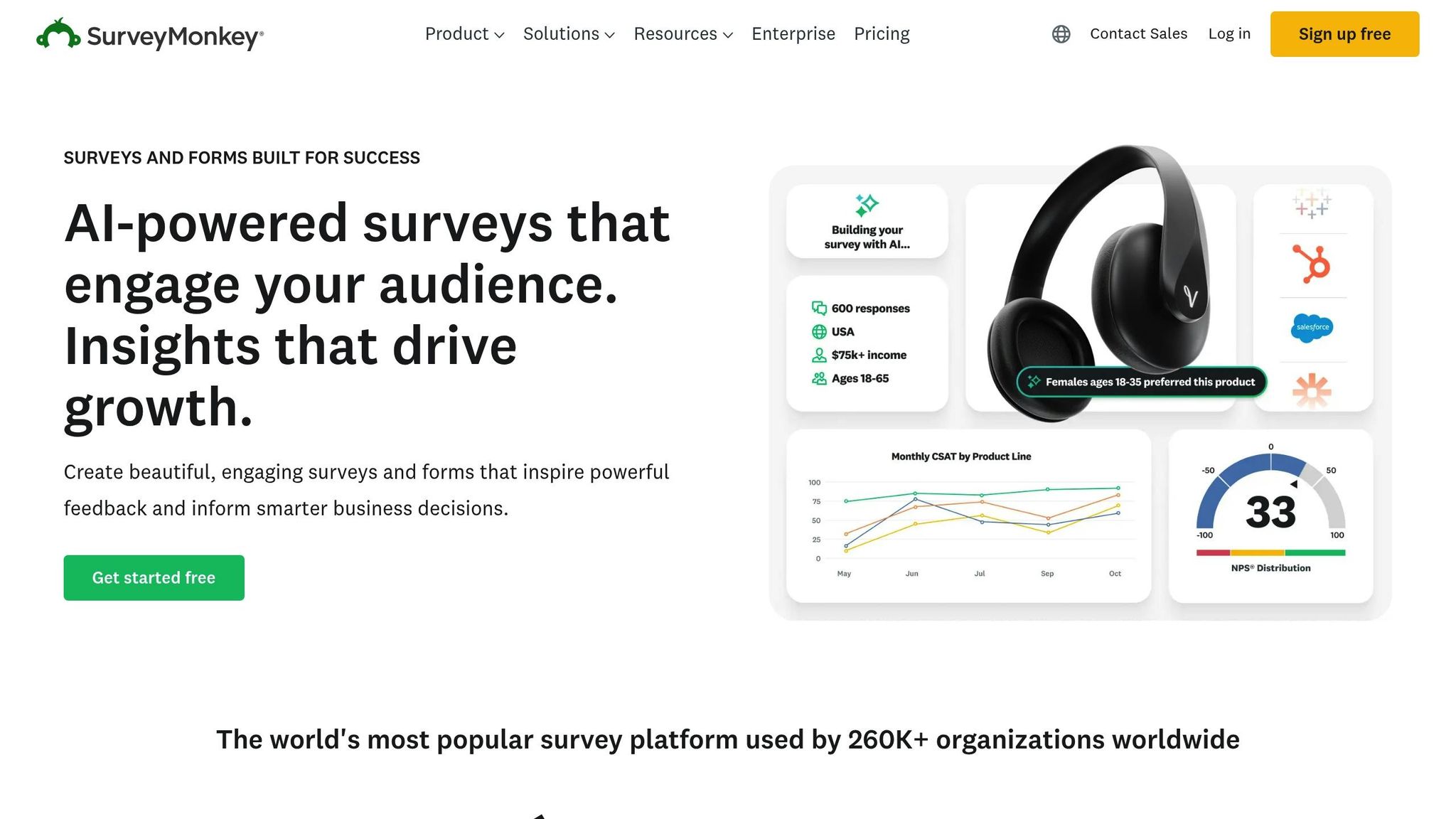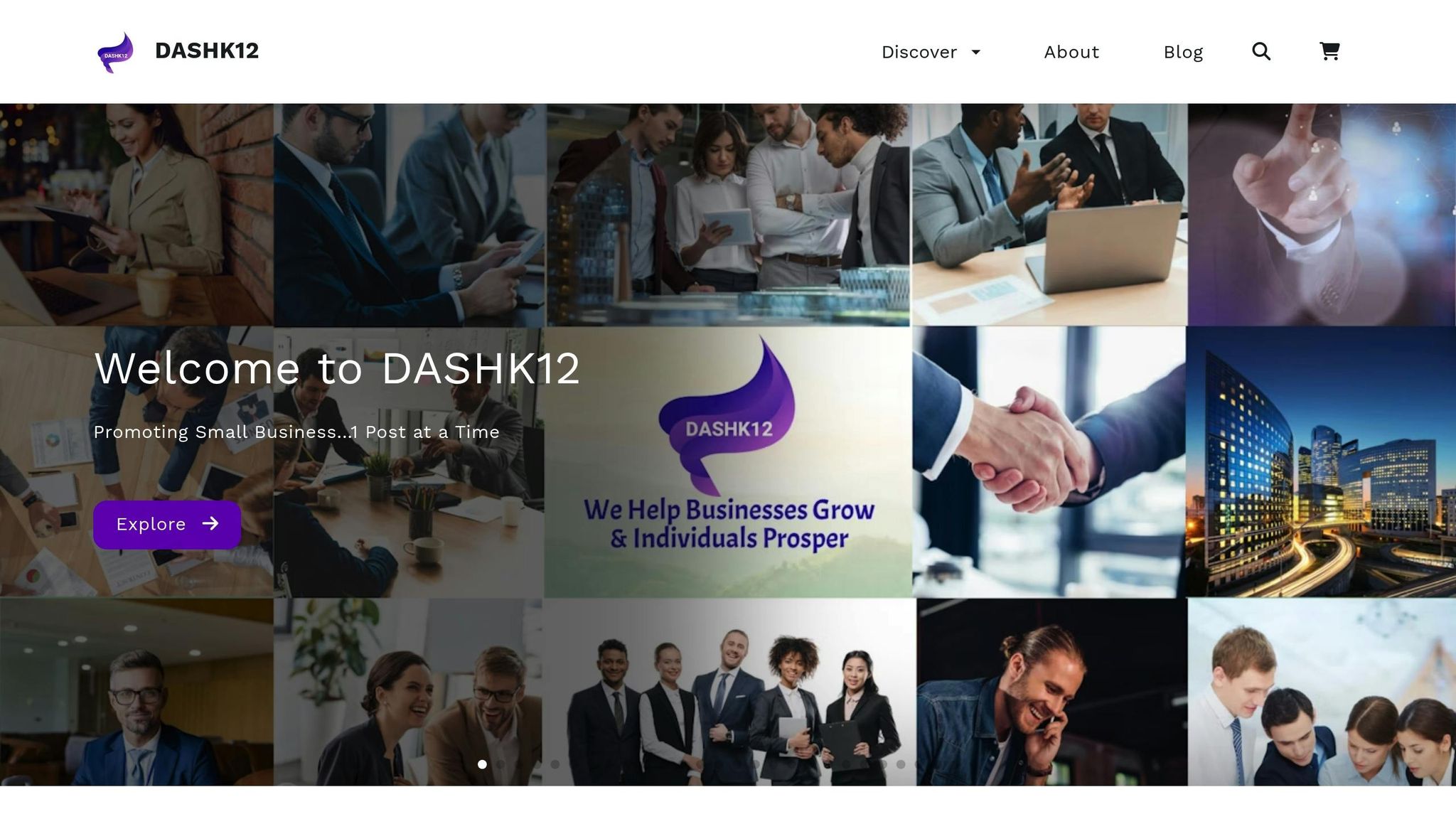How Free Tools Help Startups Analyze Markets
Free market research tools are a game-changer for startups operating on tight budgets. They provide access to essential data and insights without the need for expensive software or consultants. Here's what you need to know:
- Why They Matter: Startups often struggle with limited funding, time, and expertise. Free tools simplify market research, making it faster and more accessible.
- Key Benefits:
- Access real-time data (e.g., Google Trends).
- Gather direct customer feedback (e.g., SurveyMonkey).
- Explore demographic data (e.g., U.S. Census Bureau).
- Monitor social media trends (e.g., BuzzSumo).
- Limitations: While free tools save money, they often come with restrictions like limited features, fewer insights, and usage caps. As your business grows, you may need to upgrade to paid options for deeper analysis.
Pro Tip: Combine tools for a complete picture. For example:
- Use Google Trends to spot trends.
- Validate ideas with a SurveyMonkey poll.
- Use Census data to identify target demographics.
Free tools empower startups to make informed decisions quickly, but knowing when to upgrade is key to scaling effectively.
Top 9 FREE Market Research Tools You NEED Now! #marketresearch #musthaves #freeresource #startup
Best Free Tools for Market Analysis
For startups working with tight budgets and limited resources, free tools can be a game-changer. These five tools offer practical ways to gather market insights without spending a dime. Each one brings something different to the table, and when used together, they form a well-rounded market research toolkit. Here's a closer look at what makes each tool valuable.
Google Trends: Track Search Behaviors

Google Trends helps you see what people are searching for and when. By analyzing search queries, it reveals patterns of interest, compares topics, and highlights regional differences across the U.S. This makes it easier to spot opportunities early. For instance, the DTC brand Parade used Google Trends to notice a spike in searches for "eco-friendly underwear", which inspired a successful product line focused on sustainability.
Another handy feature is its keyword comparison tool. Want to know whether "plant-based protein" or "vegan protein" resonates more with your audience? Google Trends can show you which term gets more traction in your target market.
SurveyMonkey: Collect Customer Feedback

While search trends offer clues, direct feedback from customers fills in the gaps. SurveyMonkey simplifies the process of creating and distributing surveys to your audience, even if you’re not tech-savvy. With its free plan, startups can gather insights on product ideas, pricing, and customer satisfaction. This allows you to test concepts before committing resources, confirm assumptions about customer needs, and fine-tune your offerings.
To get the most out of your surveys, keep them short - ideally under 10 questions - and focus on specific customer groups. Multiple-choice questions are particularly useful for quick analysis. SurveyMonkey also includes built-in analytics, making it easier to spot trends in responses and share findings with your team or investors.
AnswerThePublic: Find Customer Questions

If you want to understand what potential customers are curious about, AnswerThePublic is a great tool. It collects real search queries and organizes them visually using categories like who, what, when, where, why, and how. For example, if you're starting a meal delivery service, you might find that people frequently ask, "How much does meal delivery cost per week?" or "What meal delivery service is healthiest?" These insights can shape your content strategy, FAQs, and even SEO efforts.
Although the free version limits daily searches, it’s usually enough for occasional research. It’s a simple way to address customer concerns and refine your messaging.
U.S. Census Bureau: Get Demographic Data

For detailed demographic and economic data, the U.S. Census Bureau is an invaluable resource. It provides information on population size, age, income levels, consumer spending, and geographic trends across the country. The Census Business Builder tool is especially helpful for analyzing local markets. For example, if you're developing products for seniors, you can use Census data to locate areas with a high percentage of residents over 65. This information can guide everything from product design to marketing strategies.
Plus, the credibility of Census data makes it a solid choice for investor presentations and business plans.
BuzzSumo: Monitor Social Media Trends

Social media is a goldmine for real-time insights, and BuzzSumo helps you tap into it. This tool tracks trending content, measures social media engagement, and monitors competitor activity. It shows which topics get the most shares, comments, and likes in your industry, helping you identify content gaps and stay ahead of trends.
BuzzSumo also lets you see how your competitors’ content is performing and which influencers are engaging with their brand. While the free version has daily search limits, it’s still powerful enough for regular market monitoring.
When combined, these tools offer a comprehensive view of your market. Google Trends uncovers demand and trends, SurveyMonkey gathers direct feedback, AnswerThePublic highlights customer questions, Census data enables precise targeting, and BuzzSumo keeps you informed about social media dynamics. Together, they provide an effective and budget-friendly approach to market research.
Pros and Cons of Free Market Research Tools
Free market research tools can be a game-changer for startups operating on tight budgets. However, they come with limitations that might impact their usefulness as your business grows. Weighing the advantages and drawbacks can help you decide when free tools are enough and when it's worth investing in paid options.
Benefits: Cost Savings and Quick Access
The biggest perk? They're free. This eliminates budget concerns, making it easy to dive into market research without shelling out for expensive consultants. Plus, most tools are web-based and require little to no setup. Tools like Google Trends or data from the U.S. Census Bureau can be accessed in minutes.
Free tools are also great for quick idea validation. You can test concepts, gather customer feedback with platforms like SurveyMonkey, or spot trending topics quickly - especially useful in fast-moving industries. On top of that, data from reliable sources like the U.S. Census Bureau adds credibility to your business plans or investor pitches.
Drawbacks: Limited Features and Scalability
The downside? Free tools often come with restrictions that can hinder deeper analysis. For instance:
- SurveyMonkey's free plan caps the number of responses you can collect.
- BuzzSumo's free version limits daily searches.
- AnswerThePublic restricts how many queries you can run.
These limitations might not matter at first, but as your needs grow, they can become frustrating bottlenecks.
Another challenge is the lack of detailed insights. Free tools tend to provide surface-level data, which might not cut it for in-depth competitor analysis or customer segmentation. Over time, relying solely on free options could mean missing out on valuable insights that could shape your strategy.
Integration issues are another common hurdle. Free tools rarely sync seamlessly with other systems, often requiring manual data entry - a process that can quickly become unmanageable as your team and workload expand.
Tool Comparison: What They Offer (and What They Don’t)
| Tool | Strengths | Weaknesses |
|---|---|---|
| Google Trends | Real-time search data, easy to use, free | Limited to search trends, lacks detailed analytics |
| SurveyMonkey (Free) | Quick survey creation, basic analytics, user-friendly | Response caps, fewer question types, no advanced reporting |
| U.S. Census Bureau | Comprehensive U.S. demographic data, free | U.S.-only, complex to navigate, not real-time |
| BuzzSumo (Free) | Tracks social media trends, finds influencers | Limited searches, restricted data history |
| AnswerThePublic (Free) | Visualizes customer questions, sparks content ideas | Limited daily searches, no export options |
Each tool has its strengths, but they also come with trade-offs. For example, Google Trends is excellent for spotting search trends but doesn’t provide context behind them. Meanwhile, the U.S. Census Bureau offers detailed demographic data but isn’t updated in real time.
When to Consider Upgrading
As your business grows, you may find free tools falling short. If you're hitting usage limits, need more advanced competitor insights, or want seamless integration with other platforms, it might be time to explore paid solutions.
With an estimated 90% of the world's data being unstructured, using the right tools to extract meaningful insights becomes increasingly important. Free tools can be a great starting point, but knowing when to step up to paid options can make all the difference as your research needs evolve.
sbb-itb-4f1eab7
How to Use Free Tools Effectively
Making the most of free market research tools requires a smart combination of resources to paint a complete picture. The trick is to blend tools effectively, keep your research up to date, and address the limitations of free options with creative solutions.
Use Multiple Tools Together
No single tool tells the whole story. Each tool offers a unique piece of the puzzle, and using them together helps you see the bigger picture. Think of it as assembling a jigsaw puzzle - each tool contributes a vital piece to complete the image.
Start by understanding what each tool does best. Google Trends reveals what people are searching for, but it doesn’t explain why they’re searching or how they feel about those topics. That’s where SurveyMonkey steps in, offering direct customer feedback. Meanwhile, the U.S. Census Bureau provides demographic data to help you pinpoint who your audience actually is.
Here’s an example of how to combine these tools effectively: Spot a trending topic on Google Trends, validate interest with a quick SurveyMonkey survey, and then use Census data to estimate the size of your potential market. This layered approach helps you avoid the pitfalls of relying on a single source of information.
Keep everything organized in one place. Use tools like Google Sheets or a project management platform to consolidate insights from different sources. A shared dashboard makes it easier to identify patterns and inconsistencies across data sets. Regularly updating this central hub ensures your team always has access to the most current findings without digging through multiple platforms.
Update Your Market Research Regularly
Combining tools is just the start - keeping your research current is equally important. Markets evolve quickly, and your insights can lose relevance if not updated. Aim for quarterly updates as a baseline, but be ready to refresh your data whenever key market signals change. For instance, a sudden spike in search interest for your product category, a new competitor entering the market, or shifts in demographic trends are all signs it’s time to revisit your research.
One company that nailed this approach is Calendly. By combining free and premium tools, they identified the remote work trend early and saw a 200% increase in enterprise adoption. Their success wasn’t just luck - it came from consistently monitoring market changes and acting on new insights.
Set up Google Alerts and track seasonal trends to stay ahead. The U.S. Census Bureau releases updated demographic data annually, so mark your calendar to review it each year. Changes in population, income levels, or geographic shifts can significantly impact your target market, often in ways that aren’t immediately obvious.
Get Extra Help with DashK12 Resources

While free tools provide valuable data, turning that information into a clear strategy often requires expert guidance. This is where DashK12's business consulting services can make a difference. They help you interpret complex market data and develop actionable strategies tailored to your business needs.
For example, their 2-hour consulting sessions ($100) offer personalized advice on how to prioritize insights and resolve conflicting data from various tools. This can be a game-changer when you’re unsure where to focus your efforts.
DashK12 also offers self-paced courses and planning tools like their Marketing Strategy Planner and Marketing Plan Generator. These resources help startups organize scattered data into structured, actionable plans that the entire team can follow.
Interestingly, their job interview training ties back to market research in an unexpected way. As your business grows, having team members who can clearly communicate data-driven decisions to investors, partners, and stakeholders becomes critical. DashK12’s training ensures your team can present findings professionally and confidently.
Conclusion: Free Tools Give Startups Real Power
Free market research tools have reshaped how startups operate, proving that smart, data-driven strategies can often outshine hefty budgets. These tools give entrepreneurs the chance to compete on knowledge and insight, not just financial muscle, by opening the door to valuable market intelligence.
Consider this: 328 million terabytes of data are generated every single day around the world. Tools like Google Analytics 4, U.S. Census data, and SurveyMonkey provide startups with the resources to make informed decisions - without breaking the bank.
Take the example of a U.S. food delivery startup. They tapped into Google Trends to identify growing interest in plant-based diets, used SurveyMonkey to confirm menu preferences, and leveraged Census Business Builder to pinpoint ideal neighborhoods. This strategic use of free tools led to a 30% boost in customer acquisition within just six months. Their story highlights how smart use of accessible resources can deliver real results.
That said, success with these tools isn’t automatic. While they’re a great starting point, they’re most effective when paired with expert advice and a solid plan. For instance, DashK12's consulting sessions - two hours for $100 - can help transform raw data into actionable strategies, bridging the gap between information and execution.
As markets shift and evolve, startups must stay flexible and ready to adapt. With about 90% of the world’s data still unstructured, there’s a wealth of untapped potential - but also challenges in making sense of it all. Startups that master these free tools and learn to interpret data effectively will be better equipped to thrive in today’s increasingly data-focused landscape. The ability to make agile, informed decisions will remain a key advantage as this dynamic environment continues to unfold.
FAQs
When should startups consider upgrading from free to paid market research tools?
Startups often begin with free market research tools, and for good reason - they’re handy for basic analysis and don’t cost a dime. But as your business grows, sticking with these tools might hold you back. Paid options typically offer more robust features, like detailed data insights, customizable reporting, and real-time analytics. These extras can make a big difference when you're making critical business decisions.
If your team finds itself juggling data from multiple free tools or struggling with incomplete information, it could be a sign that it’s time to upgrade. Before diving in, take a close look at your budget, business objectives, and the potential return on investment to ensure a paid tool aligns with your needs.
How can startups maximize the benefits of free market analysis tools?
Free market research tools can be a great asset for startups, especially when budgets are tight. However, they often come with certain drawbacks like limited features, smaller data sets, or reduced customization options. To get the most out of these tools, startups can take a few smart approaches:
- Mix and match tools: Use a variety of free tools together to gather a wider range of insights. For instance, combine survey platforms with free analytics tools to validate and cross-check your findings.
- Get creative with constraints: Focus on the most critical data points and actionable insights. Working within the limits of free tools can still yield valuable information if you prioritize effectively.
- Add manual research: Go beyond the tools by conducting competitor analysis, customer interviews, or monitoring social media activity to fill in any gaps left by the tools.
With a thoughtful and resourceful strategy, startups can carry out meaningful market research without spending a fortune.
How can free tools like Google Trends and SurveyMonkey work together to enhance market analysis for startups?
Free tools like Google Trends and SurveyMonkey can be a powerful duo for startups looking to dive into market analysis. Google Trends offers a bird’s-eye view of what’s capturing consumer attention by analyzing search data. It highlights current interests, emerging patterns, and even seasonal shifts, helping startups spot which topics or products are picking up momentum.
Meanwhile, SurveyMonkey takes a more personal approach. It allows startups to directly connect with their audience through customizable surveys, gathering valuable feedback on customer preferences, challenges, and buying habits.
By blending the broad insights from Google Trends with the targeted, firsthand data from SurveyMonkey, startups can make smarter, data-backed decisions to fine-tune their strategies and better meet the needs of their audience.